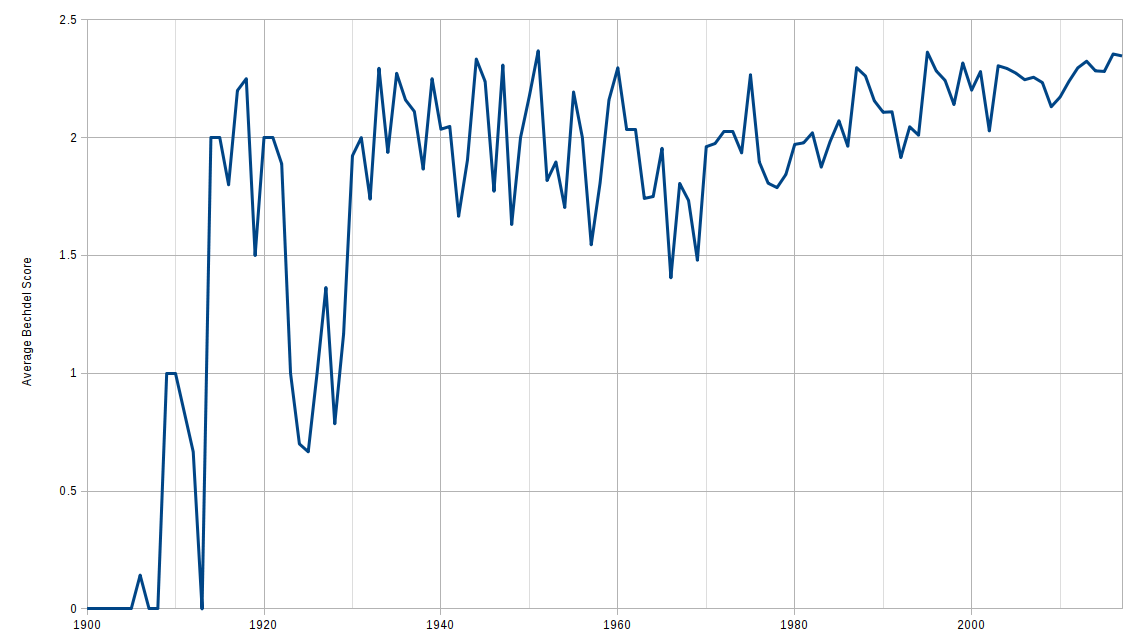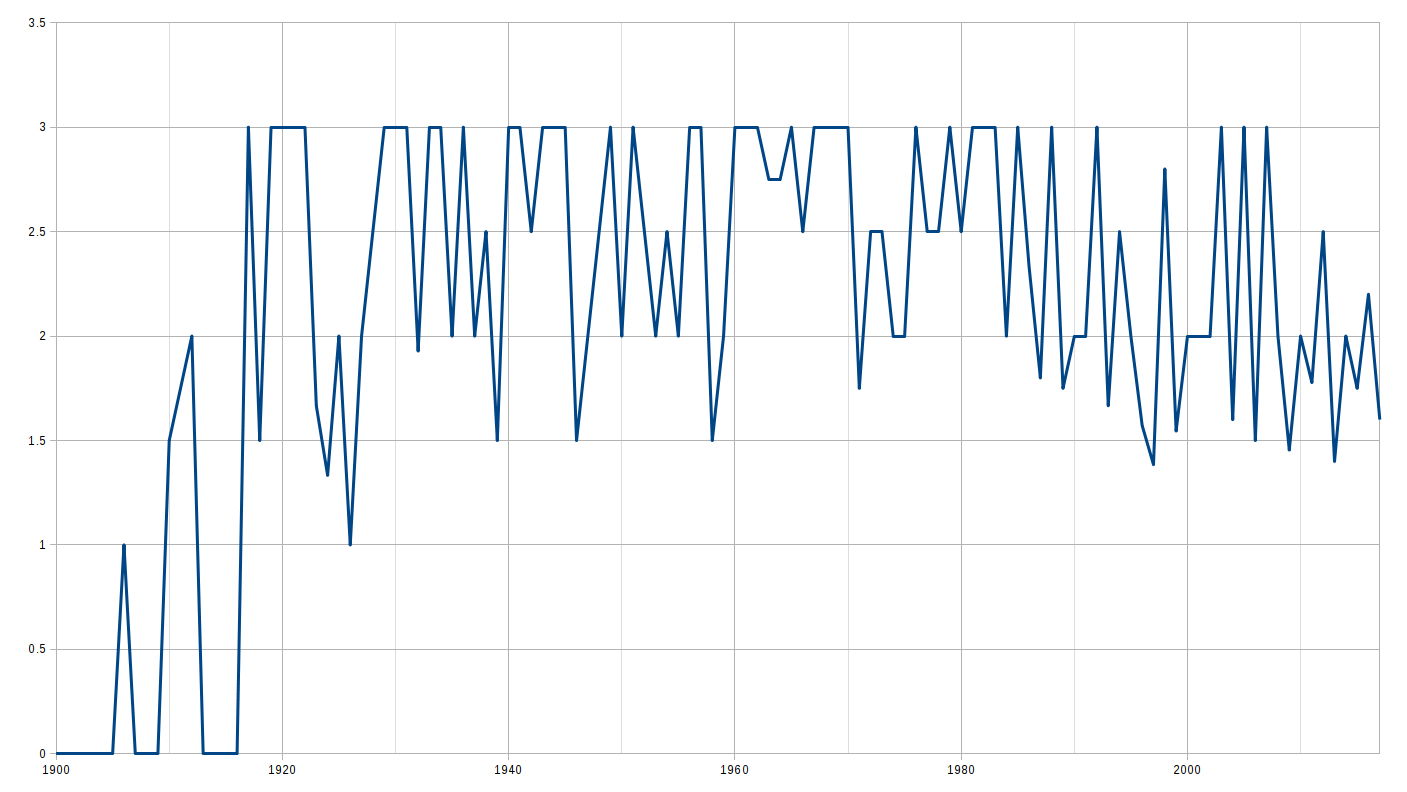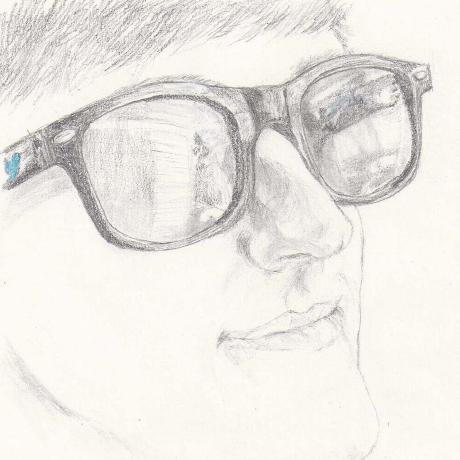So, I was thinking about the “Bechdel test” the other day, since sexism has been the “in” thing for the past few weeks. Also other reasons. Basically, it’s a test to highlight gender inequality in fiction (thank you, Wikipedia, for that description). There are three criteria that must be met to pass:
- There must be at least two (named) women in the movie,
- These two women must talk to each other,
- About something other than a man.
Then you score the movie out of three points. Higher is better.
This is great at first blush, but there are a few problems with it. First off, it doesn’t account for movies for which an active female role doesn’t mean that they must talk to each other. I don’t have any examples, so take this with a grain of salt.
But on the other end of the spectrum, any reasonable pornographic film will have two women that talk to each other (and probably a reasonable number will talk about something besides a man, though I lack the data), and I hardly consider that a particularly gender-equal medium.
Honestly, though, that’s not my point. More on topic for this blog (ha, is joke), there’s a website which provides vast quantities of user-rated bechdel test scores. I downloaded this data and did some simple number-crunching in Python.
The data comes as ratings (on a scale from 0 to 3, of the number of criteria met) for a few thousand movies, each linked to an IMDB ID. Using my TMDB database, I can download things like year and genre.
So a first test, just to make sure everything’s working, is to graph the average movie score against time:

What to make of this? With my many years of sociology research, here’s my interpretation:
- Early movies didn’t typically have women in leading roles.
- During World War 1, movies started passing the Bechdel test more and more.
- Then the Roaring Twenties came, and women went back to their more ornamental state.
- The Wall Street crash, heralding the Great Depression, and we stopped being rich enough to trample on women in film.
- Then the ratings held steady until, ironically, second-wave feminism came about in the sixties, where the ratings dropped.
- From there, the noise in the dataset lowered and the average has roughly steadily increased to present day. A lot of this is just because there are more rated movies from this time period.
That was a nifty graph. I mentioned earlier that I had genre data for all of the movies, what if we find the average Bechdel rating for each genre?
War 1.449 Western 1.467 Action 1.762 Crime 1.826 Adventure 1.856 History 1.856 Science Fiction 1.903 Documentary 1.929 Animation 1.981 Thriller 2.028 Fantasy 2.096 Mystery 2.188 Drama 2.200 Family 2.227 Comedy 2.229 Horror 2.278 10769 2.320 Music 2.412 Romance 2.431 TV Movie 2.587
That’s the list of genres with their corresponding ratings, sorted increasing down. Movies are from all time periods, averaged together.
Right off the bat: Genre “10769” is a genre that, for some reason, TMDB won’t identify in their API (it turns out to be the Foreign genre). It appears to be largely bizarre international films, including the Japanese fantasy drama horror romance action comedy movie “Negative Happy Chain Saw Edge.”
Update from a friend who can read Japanese: That’s not a mistranslation.
But, the rest of the genres are familiar to us Americans. Interestingly, if I were to rank these genres from “most manly” to “least manly,” this is about the order I would put them in (notably, I don’t by default rank them from “most manly” to “most girly”, I don’t think of these as opposite).
On the one hand, you have War, Western, Action, and Crime movies. I thought Saving Private Ryan was a good movie, but to be honest, I’d have been really uncomfortable if half the squad had been female. Saving Private Ryan fails the Bechdel test with 0 out of 3 criteria met. So War movies get a free ticket.
Jennifer Lawrence, you were good in the Hunger Games, but I don’t consider that a war movie in the same vein as Saving Private Ryan. So don’t try to do a remake of that movie. I don’t like imagining my future wives getting hurt.
Tom Hanks, you’re cool, but you’re on your own in this regard. Man up.
Western, Action, and Crime movies are in a similar boat, though much less extreme. Spectre passed only 1 of the 3 criteria, which makes sense, but the movie wouldn’t have been worse had more females talked.
Science Fiction, though, has no excuse. We put a (black!) woman on the bridge of a starship in the sixties, and we still can’t pass the Bechdel Test more often than thriller movies? How can you do worse than the Fast and the Furious movies?
Oh well. I’m not a movie maker. I’m just here to make graphs and complain about society.
Speaking of graphs, what if we look at the difference between the most manly and the least manly genres, on a per-year basis? In principle, in a very unequal world, we would expect there to be a large gap across genres - some genres would be considered manly, and others not. In a perfectly equal society, every genre would have the exact same representation.
So let’s make that graph!

And look at that, in recent years the graph has been trending downwardish for the past 20-30 years. So that’s good, I suppose.
Fair warning: The amount of data per point in this graph is just a few data points. There’s only ~7000 movies in the database, divided into 100 years is ~70 movies/year, divided into 20 genres is only ~3 movies/year/genre.
This issue is compounded by the fact that the movies are not distributed uniformly across time. Early on there were fewer movies than there are today.
I don’t have a graph of number of movies in the dataset against time, that’s left as an exercise to the reader.
Of course, the part that you all are curious about: the code. Boys and girls, this is what real I-have-to-analyze-some-data-real-quick-I’ll-comment-it-later Python code looks like: https://gist.github.com/lkolbly/8d657411cc50e1e01b164778b6239523
